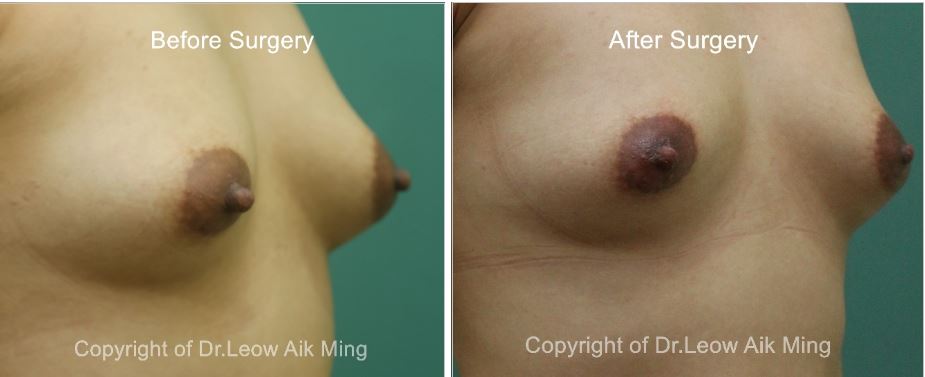Nipples present in various sizes, shapes and projections. In some cases, the nipples may have an unusually large size and may protrude further than normal. Protrusion of nipples makes them prominently visible. Such a change can be temporary and usually occurs during puberty. The hormonal changes during puberty are usually the cause of such prominent nipples that accompany the development of other secondary sexual characteristics.
Hormonal changes that occur during periods of pregnancy or lactation may also cause the nipples to become prominent. Another potential cause of prominent nipples is deformity of the tubules in the breast tissue. The protrusion caused by the breast tissue in such cases leads to puffy nipples.
Demographically, Asian women tend to be born with nipples of much longer and much broader in diameter than women in western society. Asian women’s nipples tend to be 10 to 15 mm in diameter and 20 to 25 mm in length. On the other hand, the Western women’s nipples are usually 5 to 6 mm in diameter, maybe eight, and generally under a centimetre in projection. Though after breastfeeding, most nipples would end up being a centimetre.
Nipple reduction surgery is a cosmetic procedure used to decrease the size of the nipple, though it may also include reshaping of the nipple to create a better-proportioned nipple. The procedure is most commonly requested by women who feel self-conscious or otherwise embarrassed by the size of their nipples.
Ideal candidates for nipple reduction surgery
- Patients who are embarrassed by the sizes of their nipples
- Grossly enlarged nipples after pregnancy
- Healthy individuals who do not have medical conditions that can impair healing or increase the risk of surgery
- Individuals with a positive outlook and realistic expectations
- Non-smokers
Preoperative evaluation for nipple reduction surgery
Communication is vital to achieving the patient’s goals. During the initial consultation, patients will have the opportunity to discuss their goals and desired results with the plastic surgeon. The plastic surgeon will work closely with the patients to reach an agreement about the expectations from the surgical procedures involved and their long term benefits. Every patient is different. Therefore a specific treatment regimen is planned to suits an individual’s need. The preoperative evaluation for nipple reduction surgery includes:
- Discussion about patients’ expectations and desired outcome
- Medical conditions, drug allergies and previous medical or surgical treatment
- Use of current medications, vitamins, herbal supplements, alcohol, tobacco and drugs
- Discussion on anaesthesia and its risks
- Physical examination
- Nipple examination including detailed measurements of their size, shape, projection and skin quality
- Photography for preoperative and postoperative evaluation
Preparation for nipple reduction surgery
- Get laboratory testing or a medical evaluation
- Adjust medications if for specific medical conditions
- Stop smoking and alcohol well in advance before the scheduled date for surgery
- Avoid taking aspirin, anti-inflammatory drugs and herbal supplements before surgery
- Special instructions will be given on the day before and after surgery
The risks and safety information on nipple reduction surgery
It is crucial for patients to understand that every surgical procedure has its complications and downtime. However, if a patient is assessed correctly before the surgery and postoperative care is given adequately, these risks can be eliminated or reduced.
Some of the common risks of nipple reduction surgery:
- Infection
- Bleeding
- Poor wound healing
- Wound breakdown
- Skin discolouration
- Swelling due to a blood clot or fluid accumulation
- Unfavourable scarring (hypertrophy or keloidal scar)
- Temporary numbness or changes in the skin sensation around the nipple
- Potential partial or total loss of nipple
- Asymmetry
- Possibility of revision surgery
- Anaesthesia risks
Postoperative expectations
After the surgery, temporary dressings or bandages are applied to the incision sites. During the first 2-3 days, there may be discomfort, swelling and bruises around the nipple and areolar. Oral antibiotics and analgesics will be prescribed to reduce the risk of infection and postoperative pain respectively. Stitches will be removed on 7-10 days after the surgery. The symptoms of discomfort, swelling, and bruises around the nipple and areolar may disappear completely about 3-4 weeks after the surgery.it may take months or a year for the nipples to soften and feel more natural.
Case No. 1:

Case No. 2:

Postoperative care
- Regular application of antibiotic ointment and cleaning the operated areas for the first one week after the surgery
How much will a nipple reduction surgery cost?
Cost is always a consideration in elective surgery. The cost of nipple reduction surgery can vary widely.
The cost of nipple reduction surgery may include:
- Surgeon’s fee
- Hospital or surgical facility costs
- Anaesthesia fees
- Medical tests and x-rays
- Prescriptions for medication
Nipple reduction surgery is a cosmetic surgical procedure, and most of the health insurance does not cover cosmetic surgery or its complications.
